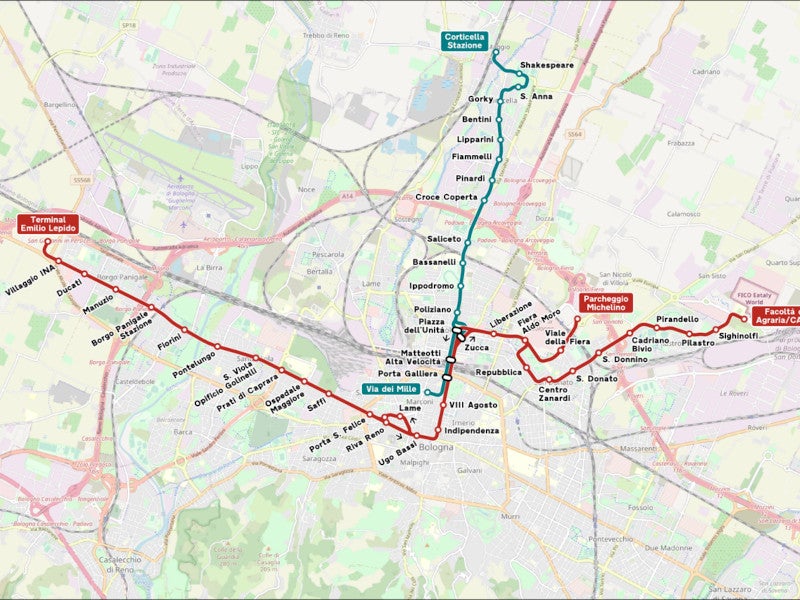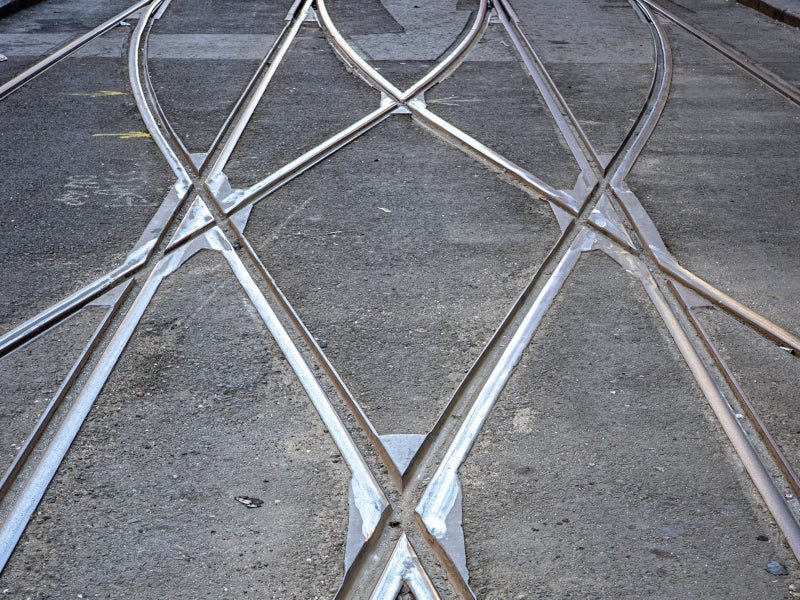The Tram Bologna project involves the construction of a 57km tram network in Bologna to reintegrate tramways into the urban transport landscape of Italy. It is being developed by the Metropolitan Railway Service (SFM), Bologna’s commuter railway service.
The tram network in Bologna ceased operations in 1963. The project seeks to revive the city’s public transport heritage while addressing the increasing demand for effective mobility solutions.
The project is being developed with an investment of €500m ($508.9m) under the Sustainable Urban Mobility Plan (SUMP), which was adopted by the Metropolitan City of Bologna in 2019.
The new tram network will consist of four interconnected lines, including the Red Line (Tram Linea Rossa), Green Line, Yellow Line, and Blue Line, with four interchange stations.
Construction on the Red Line or Tram Linea Rossa commenced in April 2023, while the construction work on the Green Line began in April 2024. Both lines are anticipated to be completed by 2026. The entire project is expected to be operational by 2027.
The tram network will transport approximately 300,000 passengers daily across the four lines and will feature a unified fare system for all metropolitan transport. It is projected to reduce greenhouse gas emissions by 40%, aligning with the European Union’s goals to comply with the Paris Climate Agreement.
Location of Tram Bologna project
The Tram Bologna project is situated in northern Italy. The tram network, with its four interconnected branches, will cover nearly the entire city, offering a sustainable mobility solution.
Tram Bologna’s line routes
The Red Line will run from Emilio Lepido Terminal and branch off to end at the Faculty of Agriculture (CAAB) on one side and the Michelino Northern Terminal on the other.
The Green Line will operate from Corticella to the Due Madonne Depot while the Yellow Line will extend from Rastignano to Casteldebole.
The Blue Line will be constructed from east Casalecchio to San Lazzaro in the southeastern part of Bologna. The exact route will be determined during the feasibility planning phase.
Tram Bologna Red Line details
The Red Line will span 16.5km, feature three terminals, and include 31 stops. The line will connect two interchange railway stations, Bologna Centrale and Borgo Panigale.
The line will start from the terminal at the western end of Borgo Panigale, following the Via Emilia axis. The line will split after the Central Station, near Bolognina, with one branch terminating near the Fiera motorway toll booth while the other continuing towards the Michelino parking lot and proceeding to the Pilastro area. The third terminal of the line will be located in Via Fanin near the CAAB.
The line is designed to accommodate 110,000 passengers per weekday, accounting for 21% of public transport journeys and attracting up to 15,000 passengers from private transport.
Travel time will be 40 minutes from Emilio Lepido Terminal to Fiera Michelino Terminal and 52 minutes from Emilio Lepido Terminal to the CAAB Terminal.
Tram Bologna Green Line details
The Green Line will span approximately 7.4km, with 5.9km on a new route and 1.5km overlapping with the Red Line. It will feature 18 stops, four of which will be shared with the Red Line.
The route begins at the southern terminal in Via Dei Mille and travels north along Via Indipendenza to Piazza Dell’Unita where it intersects with the Red Line. It then continues along Via Di Corticella, ending in the Castel Maggiore area, accessible from Via Di Vittorio, where a terminal and a car park for the tram interchange will be located.
A new tree-lined parking lot with a capacity of approximately 200 spaces will be constructed along Via Bassanelli. The Green Line will extend north along Via Di Corticella and continue to Via Shakespeare.
Infrastructure details of Tram Bologna
The tram project includes redeveloping the road network in the affected areas, along with the development of a new interchange car park in the depot area and near the Fiera-Michelino Terminal. Users of the car park can access the tram stop via a pedestrian underpass, allowing them to travel to Bologna’s city centre without congesting the streets with their vehicles.
The car park will offer over 380 spaces and include a multi-purpose hall. The interchange hub will have extra-urban bus lines north of Shakespeare station, along with a parking lot for private cars and a tram shelter area.
Bicycles are integral to the tram project. The Red Line alone will provide 12km of roads equipped with cycle paths and six new cycle stations, promoting more integrated and sustainable mobility.
In addition to the construction sites, there are permanent sites such as the rolling stock depot in Borgo Panigale, the Michelino Terminal, and a secondary area in the Pilastro area.
The Emilio Lepido depot, located on the western outskirts of Borgo Panigale, will create a new urban space characterised by large open areas, parks, green squares, urban gardens, and equipped zones.
Rolling stock details of Tram Bologna
A total of 60 trams are expected to be delivered for the project with an extended four-year warranty.
The trams will be between 33m and 35m long, and 2.4m wide. They will feature two driver’s cabins at each end and boarding and alighting doors on both sides.
Each tram will have a minimum capacity of 205 passengers and will be free of architectural barriers. They will also be equipped with advanced signalling and control devices.
The trams will operate solely on electricity. Along the new municipal network routes, the trams will be powered by overhead electric traction systems. However, the trams will use onboard batteries in the historic centre and some specific sections where no overhead power lines are available. These batteries will be recharged when connected to the catenary.
The project will also significantly reduce vehicle noise by using cutting-edge technology.
Financing details
The Red Line received €15.1m ($15.37m) in funding under Italy’s Recovery and Resilience Plan while the Green Line received more than €200m ($203.59m) in funding.
Contractors involved
The contract for the Red Line was awarded to CMB, a construction company, through a temporary association of companies, including Alstom, a rolling stock manufacturer; and Amplia, a construction company. CMB is also responsible for the construction of the Green Line.
Systra Italy, an engineering company, is responsible for project management, studies, and work supervision of the project.
The detailed feasibility study and design were provided by a joint venture of contractors, including Systra Sotecni, Architecna Engineering, Studio Mattioli, Aegis, and Cooperative Archaeologia.
Construcciones y Ausiliar de Ferrocarriles (CAF), a Spanish rolling stock construction company, has tendered its interest in the design, construction, delivery, and commissioning of the trams for the Tram Bologna project.






